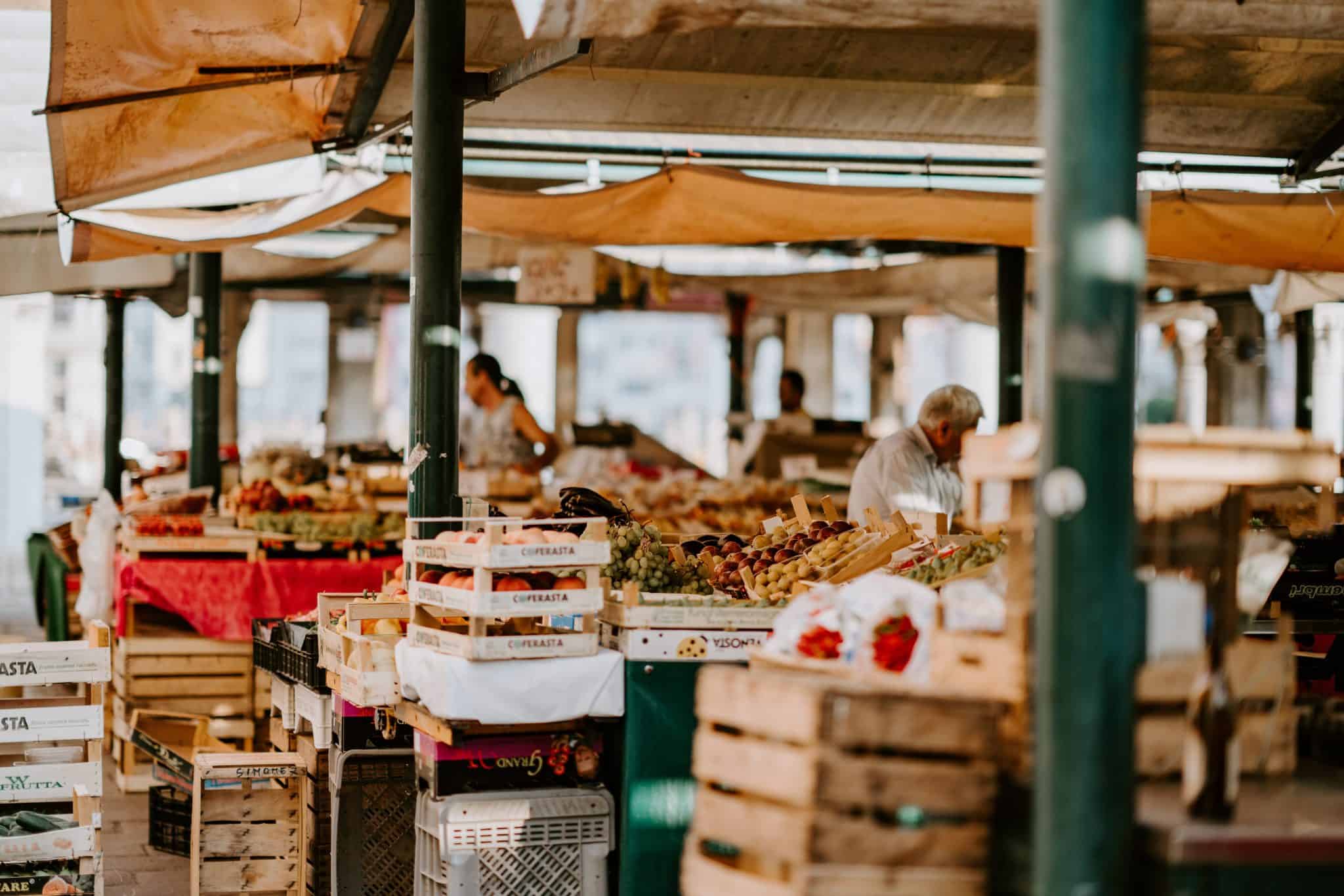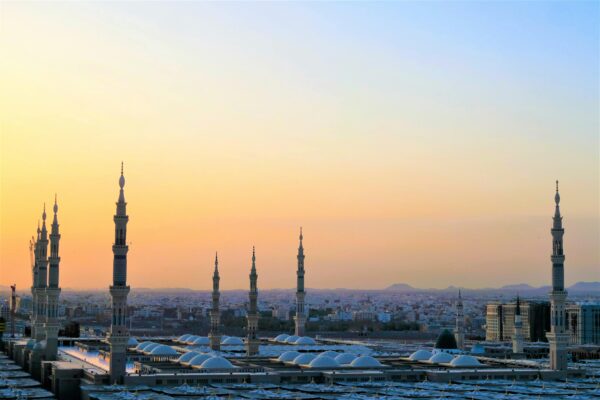Prophetic Economy – How an Islamic Economy was Born


Mufti Faraz Adam
6 min read
Last updated on:
IFG Introduction
The below is an excellent practical run-through on how the Islamic economy in Madinah during the Prophet’s time (peace be upon him) was established, how it ran (including the marketplace dynamics and rules), and the importance Islam places on bringing the sacred into our financial affairs.
This area of the seerah (the biographical study of the Prophetic period) is rarely explored fully – so our thanks to Mufti Faraz for this. It is a must-read for anyone involved in business, but also for everyone – as we each transact in physical or online marketplaces every day.
The origins of the Islamic economy
The earliest Muslims suffered and persisted for thirteen years in Makkah until the instruction from God was revealed to migrate to a small town up-north then known as Yathrib[i]. Finally, a small band of Muslims could worship God freely without persecution. The time had come to lay down the foundations of a prosperous civilisation which would eventually number over 1 billion in 1400 years.
The Prophet Muhammad (peace be upon him) arrived in Madinah to the rapture and jubilation of the emigrants and citizens of Madinah and set his sight on developing an Islamic economy.
In fact, Madinah was divinely selected and the economic factors in the selection were clear; it was the nexus for all trade caravans coming from the north and south; it was not too far from the coast and it had something which Makkah did not, a booming agroeconomy.
The Islamic economy immediately began to take shape as the Prophet laid the foundations of three Masjids; namely, Masjid Quba, Masjid Banu Salim and Masjid al-Nabawi[ii]. The landscape was redrawn with these Masjids, allowing people to envisage change and a new direction.
The Masjids proved to be a cornerstone of the Islamic economy as they provided education on Islamic trading, finance and economics as well as instilling virtuous traits within market participants.
Political Stability – a key ingredient
Any economy can crash without political stability, thus the Prophet quickly did two feats of absolute ingenuity; he established treaties with the wider communities in Madinah and created brotherhood pacts between the Muslim emigrants and native Medinan Muslims[iii].
This pact was a pact of social and financial solidarity. Reports show how the native Medinan Muslims gifted their own wealth and possession for their brothers and sisters. It was almost an encouragement to the locals to be angel investors and seed capital providers to the newly emigrated cohort of Muslims from Makkah.
Establishing the marketplace
Madinah had four markets in the following places: Zubala, Wadi Buthan in Qaynuqa, as-Safasif and Muzahim or Zuqaq. Two were controlled by the Jewish tribes whilst the other two were controlled by pagans[iv].
These four markets were located in different parts of the cluster towns across Madinah. These markets were known for their high barriers to entry, high taxes and unscrupulous practices.
The Prophet knew that the growth of the Islamic economy depended on the markets and the current markets were rife with injustices. He immediately set out to establish a market.
The narrations mention that he himself conducted a land survey to designate the ideal location. He went to two different sites which did not meet his standards and criteria.
Thereafter, a companion came and requested the survey of a site he had come across. Upon viewing this proposed site, the Prophet decreed “This is your market; trading should not be suspended nor should anyone be prevented from trading, there should be no unfair practices and no taxes will be levied[v].”
The location of this was economically strategic in the north-west of the city. It was a vast open space where trade caravans usually came and disembarked. The market was situated in close proximity to the “natural main entrance” to the city next to the mountain pass[vi].
This particular spot not only facilitated local trades, it opened up the doors to international trade, imports and exports.
The rules of the marketplace
The Prophetic decree outlined some key economic principles in how the Islamic market of Madinah functioned:
- Market forces were left to operate freely within defined Shariah parameters without complete subjugation to central planners.
- Barriers to entry which blocked potential entrants from entering the market were abolished. Thus, the Prophet negated the need for regulatory clearances, licences and did not permit favouring existing firms by protecting their revenues. He opened up a level playing field for all market participants by allowing everyone free and open access to launch a business in the market.
- Removing the barriers to entry symbolised another key economic principle: incentivising. The Prophet displayed how people respond to potential rewards. He taught how an economy needs to incentivise. The free access to the market was a key incentive to entrepreneurs. The other markets in Madinah had barriers to entry in place making it difficult to start a trade.
- Unfair practices were banned and the first signs of a true regulatory approach to consumer protection was enshrined in law.
- Taxing one another in the market was banned. The other markets in Madinah had entry taxes as well as taxes on trades. These were private taxes filling the coffers of the market owners. Such taxes were not designated to protect civil institutions or citizens, neither were they being redistributed among the people. Such selfish taxation regimes were banned in the Islamic market. This allowed people to enjoy more disposable income which was ultimately spent, invested or used in trade, increasing GDP, boosting economic growth for the overall benefit of society.
Regulation
The establishing of this new market and international trade centre necessitated a regulatory framework. The Prophet immediately installed a regulatory framework and regulators to oversee the market operations.
This institution was called the Hisbah, which was another cornerstone of the Prophetic economy. The role of the regulator was to maintain law, order and fair trading in the market[vii].
The Safety Net State
The Prophet was well aware that the dynamic state of economics meant that there would be people caught in financial distress, debt, hardship and emergency situations.
The public treasury of the prophetic government allocated most of the resources to help those in need and those struggling to make ends meet. These resources were Zakat, Sadaqah, Luqtah (lost and found items), Kharaj (land tax), Jizyah (payment for protection), Ghanimah and Fay’ (war booty)[viii].
Every citizen was guaranteed a baseline provision and support to give them more opportunities to break out of the cycle of poverty. A shelter in the form of Waqf (endowment) was introduced in the Masjid where the homeless could come and reside. This was called as-Suffah[ix].
The Prophet allocated one of the funds in the public treasury for infrastructure development and maintenance. He demonstrated the importance of good infrastructure for the development of the economy.
Conclusion
The Prophet demonstrated how a strong economy is the backbone to the preservation of faith and the faithful. What is most telling in this development is that he was very keen to establish the market and other economic institutions immediately after establishing the places of prayer. We learn that faith not only requires prayer, but a strong and functioning economy.
References
[i] Ibn Kathir, al-Bidayah wa al-Nihayah
[ii] Ibid
[iii] Ibn al-Qayyim, Zaad al-Ma’ad Fi Hadyi Khayr al-Ibad
[iv] Badr ‘Abd al-Basit, al-Tarikh al-Shamil li al-Madinah al-Munawwarah, (Madinah, n.pp, 1993), vol. 1 p. 236.
[v] This translation encompasses all the different commentaries and word variables mentioned by the narrators.
Ibn Majah, Sunan ibn Majah
Ibn Shabbah, Tarikh al-Madinah
Al-Maqrizi, Imta’ al-Asma’
Al-Samhudi, Khulasatul Wafa’
[vi] Abd al-‘Aziz Abdullah b. Idris, Mujtama’ al-Madinah fi ‘Ahd al-Rasul
[vii] Al-Qarni, al-Hisbah fil Madi wal Hadhir
[viii] Al-Kasani, Bada’i al-Sana’i
[ix] Al-Salihi, Subul al-Huda wal Rashad
Comments (0)
Related Articles
View all
Wahed Invest – A Detailed Review & How to Use It (2025)
24 July 2025 15 min read

The Fall of Riba in the New York of Ancient Arabia
21 March 2025 4 min read



Leave a Reply